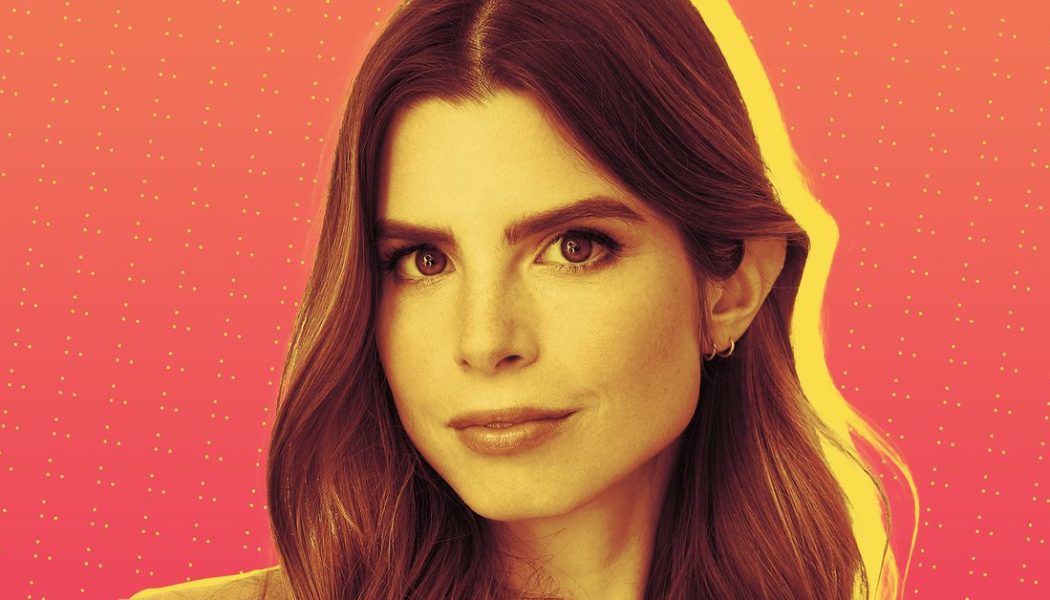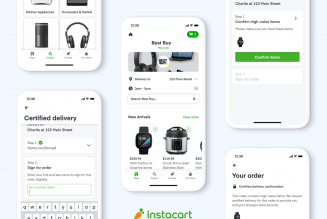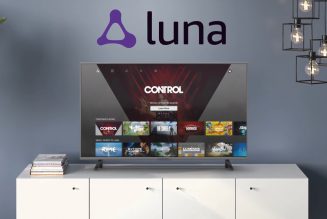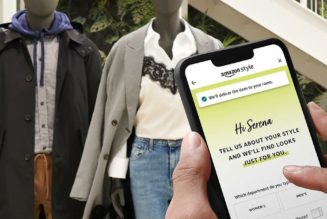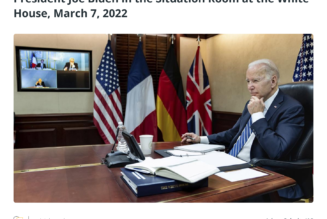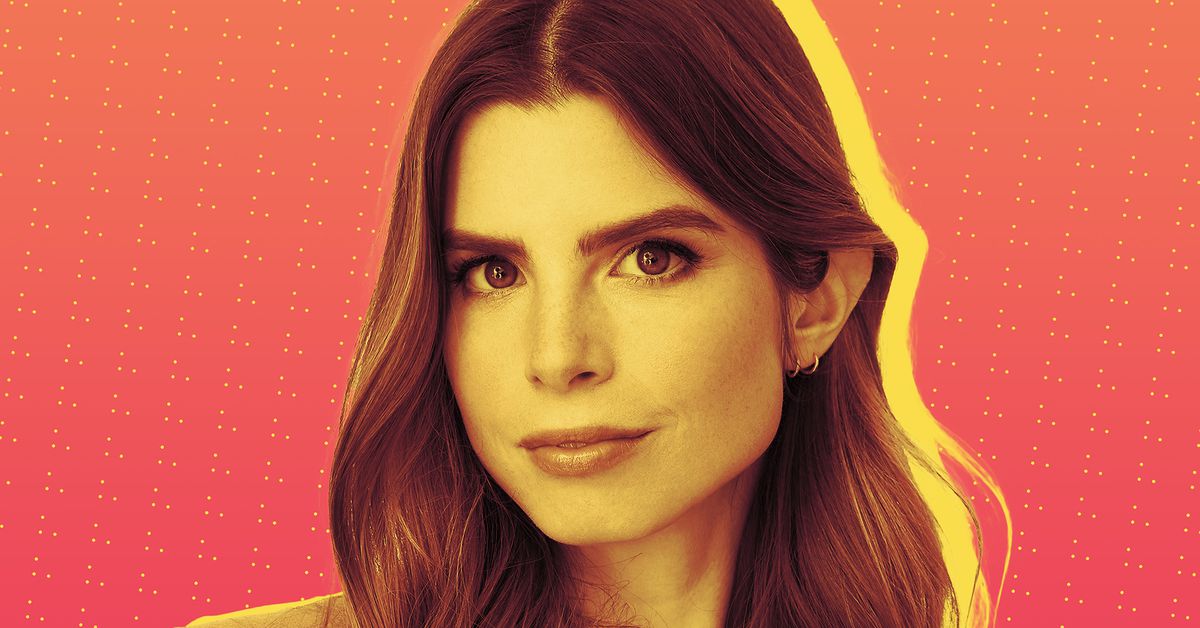
We talk a lot about the creator economy here on Decoder — the booming business of individuals using social platforms to build audiences and then finding ways to monetize those audiences, mostly through subscriptions or advertising. There are a lot of players in that game: we’ve talked to the creators about how they make money, we’ve talked to CEOs and CMOs about how they’re spending their ad dollars, and we’ve talked to a lot of executives from social platforms on how they see all of this growing.
One thing I’ve learned from all those conversations is that the creator economy is a market just like any other, with supply and demand, but that it’s also a market that is absolutely starved of information. So today I’m talking to Lindsey Lee Lugrin, the co-founder and CEO of a new platform called Fuck You Pay Me, which is an all-time great company name. FYPM is an app for creators to review and compare brand deals: what brands are paying, what it’s like to work with them, and whether people would work with them again. It’s kind of like Yelp or Glassdoor for influencers.
Lindsey’s an interesting founder — she has a master’s in finance and was an equity analyst at an investment firm. But she was also a freelance model and influencer, and she’s used that network to build FYPM’s user base. The company is still just two people, Lindsey and her co-founder Isha Mehra, but they just secured their first pre-seed venture funding and they’re looking to hire and grow. So in addition to talking about the creator economy, Lindsey and I talked about growing her startup and how she’s planning to scale — after all, right now, she’s reviewing all the user signups herself.
Here’s Lindsey Lee Lugrin, CEO and co-founder of Fuck You Pay Me.
This transcript has been lightly edited for clarity.
Lindsey Lee Lugrin, you are the CEO and co-founder of an app called Fuck You Pay Me, which is a delightful name. Welcome to Decoder.
Thank you.
All right. What is Fuck You Pay Me?
We call Fuck You Pay Me a Glassdoor for influencers. Right now, that means if a brand reaches out to you about a sponsored post on any social media platform, you can look them up on our website and see how much they paid other creators for similar types of sponsored posts.
The entire creator economy runs on branded content advertising integration, and there’s a whole background economy to it. If you’re an influencer on an app like Instagram or TikTok or something and I’ve got a product I want to sell, I can reach out to you, I say, “Hey, will you feature my product?” and then the two parties negotiate.
You’re trying to create transparency around the rates for that integration. The purpose of your site is to create or expose the rate card for influencer marketing, right?
Really, the purpose is to help creators evaluate the opportunity cost of partnering with a particular brand. Because you can always partner with a different brand, or another, better option is always to invest in your own personal brand. So, it’s just helping them answer the questions: “Is this $400 they’re offering me for this one Instagram post actually worth my time? Are they going to take forever to pay me? Is it going to be a good experience? Are they going to make me redo it a hundred times before it happens?” Because that is absolutely something that happens all the time.
So “Is it worth your time?” is a really good frame, and then “Are they going to pay me?” is another good frame. So, tell me about the name Fuck You Pay Me.
Well, I didn’t want there to be any misunderstanding of exactly who this was for. There are a lot of websites out there who connect brands and influencers, and you go to the website and you see, “Influencers, log in here; brands, log in here.” They’re all named the same super-techie type thing, and at the end of the day we all know who those platforms are for. So, I named it Fuck You Pay Me because it would be absolutely clear that this was for creators.
That’s great. You have been a creator yourself. Give me a sense of how you ended up founding the app, and tell us about your co-founder as well.
I’ve had this idea for about a decade. I actually created the first PowerPoint for it three years ago when I was in grad school. It’s really funny, it was very crypto-based, smart contracts, because it was more focused on the freelancer side. I started off as a freelance model, and had the same problems as creators. You feel like you’re looking into a black box when considering taking on a new client or taking a job.
Wait, hold on. Sorry, you said model. You were a model, that’s what you mean? Not the model for the company was freelance. You were a freelance model?
Yes.
Okay, just making it clear.
Yes. Actually in 2015, I won the #CastMeMarc Instagram contest where I was one of 11 people chosen out of over 750,000 people to be the face of Marc by Marc Jacobs, and I was on billboards all over the world, I was in magazines, I was on shopping bags. It was crazy. And I only got paid $1,000.
Are you serious?
Yes, and to this day, that was my highest-paid gig. On paper I looked super successful. I was sold as wall art in Urban Outfitters, I was in Italian Vogue, I did New York Fashion Week. I was in New York magazine. The list goes on and on and on.
(Disclosure: Both New York Magazine and The Verge are divisions of Vox Media. New York Magazine was acquired by Vox Media in 2019.)
But the fundamental principle is, it’s really hard to get paid and it’s really hard to decide if this is the opportunity you should take. Back in the day the thought was “Oh, this giant brand could make or break my career as a freelance X.” I say freelance X because all of my photographer friends, makeup artists, all creative freelancers have the same problem. We talk about this all the time.
So there’s a backchannel of freelancers in the creative community who are talking about rates, who are talking about what it’s like to work with various companies and agencies, and your thinking is, “I’m going to use crypto to make it better.”
That was the old thinking.
That’s great. I appreciate that.
Yeah, we’re trying to figure out where exactly crypto comes into our current model. I do think there is a spot for it, but right now, most of our users and customers need cash. So this is an ongoing discussion I’m having with my co-founder. There’s absolutely a place for it, especially with Ethereum smart contracts and all that stuff. We also don’t want the value to be view-based, because a lot of the things that go into brand deals, which is what we’re focused on now, you get higher rates for usage rights, terms, whitelisting, stuff like that. There’s a lot that goes into it. It’s not just about audience size.
Your first MVP [minimum viable product], I was just doing some reading before you came on the show, your first version of this, you just built using a bunch of consumer SaaS products like Airtable. How did that go, and then how did you end up with a co-founder?
I’ve had this idea for forever. At the beginning of the pandemic, I lost my job in marketing, and I lost all my money, my relationship, and my house within the six months after I lost my job. I moved back in with my parents and I decided, screw it, I’m going to build this website I’ve always wanted to exist, because it probably could have prevented this from happening in the first place. I started off by sending it to all of my friends who are also bloggers and creators, and asking, “Hey, would you sign up for this website?” Ninety-nine percent of the response was like, “Yes, absolutely. Finally. I’ve been waiting for this to exist.” That’s how it started.
I hacked together the first version using Typeform and Airtable. The Typeform survey actually took about 40 minutes to fill out, which is crazy.
That’s a lot.
Yeah, and I used my marketing skills to build out the brand page, and through that, we got natural user growth, natural press, and I hacked my way into an actual hacker fellowship for engineers because I was the only non-engineer they let in. At that hacker fellowship I met my co-founder, Isha Mehra. She’s fucking amazing. She used to work at Facebook as a data scientist, but she quit because she wanted to do something more to help people to use data for good. Basically, she quit around the time the election was happening, and she built software to help people request mail-in ballots for the 2020 election. She raised money for it, she hired 40 people. She’s the OG.
So together in Taiwan — this fellowship was also in Taiwan — we rebuilt the whole website. It still works similarly to how it worked before: you sign up, you tell us who you are so we can make sure you are who you say you are and verify your review, and you have to leave a review. So the rule is you have to contribute to be a part of the community, and then after that, we approve you and you can see what everyone else has to say about different brands.
When you say we, it’s just you and your co-founder?
Yes, yes. Right now it’s just me and my co-founder.
How many approvals do you do a day?
Right now, with minimal marketing, we get about 40 people a day who try to sign up, and it varies how many we approve. Actually, this next year is about streamlining our onboarding process and creating a platform that’s very sticky and that can scale. Right now it’s still me manually checking out everyone who tries to sign up and manually uploading every review.
That seems like a lot. How long does it take you to review one person?
What do you mean?
I’m assuming for most people, they end their day with the decision, “I’m going to watch trash TV.” I have a picture in my head where at the end of your day you’re like, “Well, time to look at approvals.” You’ve got a stack of 40. How long does that take you?
Oh. Well, most of them haven’t filled out all the parts right now, so it doesn’t take me very long.
Well, that’s the interesting part of being a founder, right? You’re doing all the jobs down to making sure people filled out the form correctly to sign up for the platform. How do you expect that to scale? Is the problem that you’re doing it alone and you want to make that time shorter? Will adding people help? Can you, I don’t know, do some AI thing?
Well, this is what we’re working on right now. Step one is finding good people who can help us scale. We’re going to build out our engineering team and our product. Isha and I have a lot of conversations about, is this a product problem or a marketing problem? My view is I really think that marketing isn’t an add-on, it’s something you design and build within your product from the ground up. So, when I’m thinking about this next year, I really want to hire a content assistant to help us repurpose content and keep up the audience while we focus on product.
Our first way to scale, because a big reason this whole thing works is that it’s anonymous internally, and our users trust us because they know going into it that only other people within the same community are allowed inside. So we’re trying to come up with a system that allows some sort of connection to your social accounts for instant limited access that gives them a tease of the preview, and then they have to leave a review before they’re allowed to see everything.
So, thinking about just putting together what I’ve learned through approving people and disapproving people, there’s lots of little things that fake people do, and things that legit people do, and just building that into the tech in a safe way, I guess.
Well, I asked about scale because it leads me into the exciting news that I want to talk about. You just raised your first pre-seed round of funding.
Yes.
Tell us about that.
Yes, we did. We just raised $1.35 million, and we’re super excited about it. We can hire people and build out our product.
You can’t see Lindsey, but she’s grinning. Congratulations.
Thank you so much.
You’re obviously very excited about it.
Yes.
So, you got your first little bit of pre-seed money. What are you going to spend it on? What’s the first set of priorities for that cash?
Product is the number one thing we’re focused on this next year. And to me, that means building out our engineering team, which includes a full stack software engineer, a UX/UI designer, and a content director who can help us repurpose our existing viral content, not only onto Instagram but other platforms, and keep our community growing and talking to each other while we figure out how to bring that community onto our platform. And I firmly believe that marketing is integrated into the best type of products out there. So we have a lot of discussions about the right type of people to build this out and how to integrate the two functions. I learned a lot through my experience in equity research, talking to CEOs and picking stocks, and especially within the consumer space on how viewing different parts of the organization separately kind of creates conflict and not synergies. So I’m taking an integrated approach to hiring and product as a whole. Does that make sense?
Yeah. Absolutely. I think one of the really interesting things about that is you’re still looking at the social platforms for user acquisition. So you’re a service for creators, but you kind of have the same challenges as creators where you want to be diversified on platforms. I just want to understand that a little bit. Why do you think your user acquisition still happens on the platforms themselves?
Well, the platforms, they change every quarter. No two brand deals are the same. We really centered our product around brand deals because a lot of these deals occur across multiple platforms. That’s something I think our competitors are doing wrong is they’re focusing on average price for Instagram posts or average price for TikTok videos. And that doesn’t capture all of the nuances within these brand deals. It doesn’t capture your relative value of celebrity. And we want to create something that incorporates all those nuances, because that’s how creators think. When you’re approached by a brand, a brand wants you for a reason. If they wanted an Instagram post, they could just take out an ad. If they wanted a TikTok video, they could take out an ad. But there’s a reason why they’re picking you over the ads on the platform.
So really this is about integrating all those nuances and making it make sense to our users. So right now our website is just a basic review site. And it’s closed because our community knows all these other nuances that can go in there.
So just real quick, so people have an understanding. Tell me, if I’m an influencer, how does a brand deal work, start to finish?
It really depends. If you are like me and you’re a niche, micro-influencer, typically the brand will email you or DM you on whatever social platform you’re on and say, “Hey, we love your work. We’d love to collab,” and keep the ball in your court. You can either accept immediately if you’re excited to get the deal, or you can say, “My rates are X, Y, and Z for X, Y, and Z.” And then they either say yes, they negotiate, or they say, “No, we just wanted to pay for product.” If you have a manager, you divert them to your manager. Or you can go through a PR company, or you can go through one of these third-party platforms that connects brands to influencers. There’s literally no rules.
And that’s a big reason why we centered it around the brand because we’re collecting data on which platform or which method gets you the best deal. So far, people who have managers always have the best outcome for themselves. Because they know how to talk numbers, how to talk marketing-speak, and how to increase your rates.
I’ll tell you my favorite story about one of my friends who’s an influencer getting a manager. He literally didn’t have a manager. He just asked his brother to start replying to his emails saying, “I’ll do it for slightly more money.” And he doubled his revenue for the year. He was like, “It felt rude for me to do it. So I just had my brother do it.” And it was just like, “Yes, but I’ll do it for 20 percent more.” And because it felt professional, the rates went up. There’s just an aspect of not wanting to be the bad person yourself and just offloading that to someone else and making that a little more sterile and less personal that I think works really well.
So there’s no rules there. If you’re a smaller influencer the brands reach out to you. There’s a flip side to it, right, where you start pitching yourself. When does that start happening for people?
When you start pitching yourself?
Yeah. If you’re one of the biggest influencers on the platform, right now you’ve got an army of agents and publicists and managers and they go out looking for deals from the biggest companies. Does that only happen for the biggest folks or do the mid-tier influencers get those opportunities as well?
Well, define “biggest folks” first. Are we talking about audience size?
You’re the expert. You tell me. I’m thinking of the most famous influencers in the game. The D’Amelios have a show on Hulu, right? It seems like they’re not waiting for the deals to come to them anymore. They’ve got an army of people who are proactively seeking ways to exploit their reach. Is that reserved for that category, or is there a number of followers or reach or influence you can have?
Because the flip for me personally would be, I wouldn’t want to build a channel where I’m constantly dependent on other people coming to me with money, but I’ve built a product that I can practically go and sell and create stability.
Yeah. Brand deals are inherently unstable. A lot of the time these are one-off gigs. So that plays into it. I think once you get to the type of scale you’re referring to, your choices are drastically different. You can be a lot pickier with brands. And a lot of the time you shouldn’t do a brand deal, but then again, everything’s personal. Also right now we have a lot of brand deals, at least from our manager portal. The first version of the site I created, I just had myself in mind. I manage and negotiate my own brand deals. But now we have a manager portal. So managers can sign up, sign the influencers up they work with, and leave reviews and search reviews and all that. But we have a lot of people who are traditional celebrities, like a 50-year-old Food Network star. His manager signed up and he only has 15,000 followers on Instagram, but he’s a huge celebrity. His situation is obviously completely different than someone who’s starting from the ground up as a normal person who has 15,000 followers.
It’s a hard question. These are all the questions we’re trying to answer. It’s just there’s so much data and they’re in so many different places. So there’s not really a point because everyone is so different, and that’s why we’re focusing on helping people build the context around someone else’s experience. Eventually in the future I think it’d be cool to allow people to reveal more information about themselves on the platform to their community and maybe build in some sort of influence within the platform. That would be cool. But we’re being very careful about how we approach that because it’s just very early.
The reason I ask is because the creator marketplace — this whole social platform, brand deal economy — it’s really early and no one knows how it works. And I think there’s a lot of pressure. There’s a lot of people out there who are very eager to tell you they know how it works. But it still seems inherently unstable to me and pretty risky, because I couldn’t tell you how much anything should cost.
Exactly. And that’s why we’re never going to tell anyone how much they should charge, because inevitably you can’t do that at scale. Everyone is different. You can’t accurately capture that in a way that is for the benefit of the creator. People just want information to make better decisions about themselves or their clients because absolutely, once you get to a certain scale, like what you were talking about at the macro-influencer level, it is better for you to outsource that and have someone managing deals for you.
One of the things we always talk about with the platforms is how their content policies affect what gets made. So YouTube, I think, is most famous for changing their policies. They decide, “We don’t want any more prank videos.” And then all of those YouTubers had to become like family vloggers. And then YouTube was like, “This is getting creepy,” and they turned that down. And then everyone moved on to something else. Do you see that same kind of influence from the money side where brands want different kinds of integrations, different kinds of things that shape what gets made?
Absolutely. And for the most part, those types of deals are the ones that get the negative reviews. Actually, on that note, only 11 percent of our reviews are negative; 52 percent are positive. The rest are neutral. But creative freedom is absolutely something that leads to a positive review because at the end of the day, it goes back to what I said earlier. If you’re a brand and you want someone to create content for you in a specific way, you should just hire a pure content creator, not someone who’s also trying to build their own personal brand in this space.
So, say I’m a micro-influencer on TikTok — which is my destiny, I have to be honest.
Define micro-influencer.
I don’t know. That’s just a word I want to use. So I’m a midsize influencer on TikTok. And I don’t know who’s going to come up to me, maybe Shell Oil is going to roll up to me and say, “I want a post.”
Really?
Why not? And I’m going to go onto Fuck You Pay Me and I’m going to look up Shell Oil. And I’m going to see a bunch of reviews that are like, they underpay. They pay late. They want more than what you could get if you just did a campaign with Banana Republic or whatever, some more traditional influencer marketing agency. And I would say, “No, this isn’t worth my time.” Is that kind of the flow you’re looking at?
Yeah, absolutely. Right now a big reason people come to our website is to just check on brands. It’s the only thing out there that exists where they can check. Everyone’s curious, because you don’t know. You’re like, oh, they offered me $1,000. To me, that’s a lot. But to the brand who makes $400 million a year, that’s negligible. And they just want to know if they’ve gotten screwed. But hopefully how our existing users will use it in the future is: They get approached by a brand. They’re considering taking on a job. They go onto our website and they just want to see other people’s experience. And you can filter by platform, by the brand industry, the country — that makes a big difference. Also, the niche of the influencer. We found that meme pages and petfluencers tend to really undersell themselves, which is interesting and also might make sense considering there’s not a human likeness attached to it. Yeah. It’s fascinating.
One of the things that you mentioned that I kind of want to dig on is, you said it sometimes it’s better to just invest in yourself and your own content. You have been a creator yourself and we talk to creators on the show all the time, but it occurred to me that you only have so many hours in a day. And you have to invest those hours in the day towards whatever you think is going to get you the most value. And some of that time is just spent, I don’t know, billing and invoicing and trying to collect. But some of it is spent making ads, content for other people. Some of it’s spent making content for yourself. What’s the balance? How much does it have to be worth for you to take a deal versus invest in your own growth on your page organically? Because that seems like the central tension here.
Exactly. It’s a personal decision. Everyone is different. Every brand deal is different and that’s what our platform does. It helps people put into context other people’s experiences with brands and see how relevant it is to you and your personal situation, which changes over time and changes with how you evolve.
So you said you were an Excel whiz before. I imagine, I can envision an Excel spreadsheet that’s like, here’s my rate per hour. Here’s the value in follower growth or subscriber growth or whatever if I make great organic content. And as various numbers about my social accounts change and grow, you can write an Excel formula that spits out a dollar amount for what you should charge.
No.
You can’t do it that way?
No.
That’s just how my brain works.
Yeah, yeah, no. That’s how a lot of people in business and tech’s brains work.
Thunderously dunked on, on my own show.
No, no, no. Sorry. That’s fine, but that’s not necessarily how a creator’s brain works. And that’s why we will never try to tell anybody how much they should charge. There are a lot of platforms out there that do that. That is not our business. That is not why people come here. People come here for information. People come here to hear other people’s experiences within their community. And they come here to evaluate or get more context behind, “is this worth my time?”
So also this next year, it’s not just about streamlining onboarding. It’s about helping our users put into context what these other people’s reviews mean. We want to build out the brand pages. A lot of that involves putting into plain English what their finances mean, if they’re a public company, if their brand is part of a larger parent company, how much money they make. Are they a startup? Have they gotten funding? What are they prioritizing? How relevant is their brand to your personal brand? Because if you’re going to accept an ambassadorship, which is a commitment to a particular brand for a long period of time, how much does that benefit you versus them? So it’s an art and a science. And everything else out there captures more the science part. And we capture the art part, I guess.
Yeah. That’s really interesting. And that’s because of your focus on just the creators, right? You’re not trying to build some two-sided marketplace where you’re finding deals for both sides.
Absolutely. Absolutely. Right now, we’re focused on providing value to our users and then how to monetize will come later. Through the Instagram page, it’s a constant feedback loop. They tell us every day what they like, what they don’t like, what they want, what they’d be willing to pay for. Being connected to brands is not something on the top of their list. So we just raised a pre-seed round and we are hyperfocused on delivering value to our users. And I think the clear monetization plan will come later. I have a couple of ideas. But right now being connected to brands is not something they’re asking for.
The brands will find you on social media, that much seems clear. When you were out raising this pre-seed round, were investors focused on monetization or was it, build the product, make it good, get users and we’ll figure it out later?
The ones we accepted money from were, build a product, make it good, and figure it out later.
Give me a hint. You said you had some ideas. What’s the shape of those ideas to monetize?
Yeah. So we have a couple of ideas. One, the most obvious idea, is to charge our users a subscription or a tiered subscription to access the data. I personally don’t want to do that. I would like to keep access open for the people who need it the most and explore more the research side, in aggregate of course. Everybody wants to know about the creator economy right now. Figuring out the TAM of this industry was a huge challenge I faced and a huge challenge everyone knows. And a lot of these brand deals—
Wait. TAM is total addressable market?
Yes. Yes.
It’s clear you have only been talking to investors. I’m just making sure I know what you’re talking about.
Oh, yes. Yeah. Sorry. Total addressable market. It’s the market size. And it’s a difficult question to answer because most of these brand deals occur under the table and they occur under the table for a reason. And we are really the only place that is capturing the broad scope of where these deals are happening.
So what do you think the total addressable market is?
That’s a good question. That’s a really good question. That’s actually exactly what we’re trying to figure out right now. And we are at a super early stage. Honestly, I think it’s in the trillions. Yeah. If I had to give a number, that’s what I would say. It’s huge. Yeah. That is the question we’re trying to answer honestly.
And you think that’s the total creator economy, the amount of money flowing into creators and through platforms in some way.
Not through platforms, through brand deals.
The reason I ask is because we had Doug DeMuro on the show – he’s a very popular auto YouTuber – and I asked him, how do you make money? And I was expecting the long list of creator economy revenue sources, brand deals, merch, the whole thing. And he said, “No, I just use YouTube Preferred.” And the platform takes a cut and provides midroll advertising on his videos and that’s his whole money.
I think Instagram would like to become a shopping mall and just take a cut of everything that you buy in Instagram — I don’t think it, I know it, as I watch Instagram evolve. It is becoming a shopping app in a very direct way. That is the other side of it. The platforms want to broker the deals. They want to connect the brands to the influencers. They want to run the ads. They want to eventually become the commerce destination.
Where do you see the kind of deals that you are focused on playing in that larger ecosystem? Does it become a larger part of that whole ecosystem? Do the platforms threaten the smaller brand deals? How do you see that shaping out over time?
Well, you can’t control what people do. You can only try to convince them that it’s their own idea. So if, for both parties, there’s a better outcome to occur outside of a third-party platform, that’s what’s going to happen. I think that there is a place for platforms to capture brand deals. I think that occurs more at the macro level, not the micro level. And I think with what we’re building, convincing micro-influencers to just do the platform will be a hard sell, I guess. I think there’s a combo of both because there’s also different types of marketing, too. What you’re describing is essentially affiliate sales. And that doesn’t capture the entire scope of brand deals. In a long-term partnership, you’re attaching your face to a name. And that includes a lot more terms than just how much it translates into sales.
So that’s in the sort of classic marketing funnel, you’re talking about brand advertising, not direct conversion to sales, which is Google Ads or whatever. You think that influencers are going to stay way at the top, at sort of the brand level, not at the click-to-buy level.
If you’re a niche micro-influencer, a lot of the time these affiliate deals aren’t going to be the biggest source of your income because of the cap on your audience size. So it would be better for you to invest in your personal brand and building your audience then taking on that partnership because that takes a lot of time. And that takes away time from you creating content for yourself.
So I’m just reading your stats right now. You have 1,500 creators on your platform with more than 2,000 reviews of 1,300 brands. That’s a pretty healthy dataset. What have you learned? What platforms pay the most money to creators?
Well, right now it’s Instagram. But that might be very much a function of all of our marketing being done organically on Instagram. Probably 80 percent of our reviews are for Instagram collaboration. It’s also a function of Instagram being kind of a legacy model for brand deals. It started there and in my opinion, brands go where the eyeballs go.
You were actually profiled in The New York Times by our friend Taylor Lorenz. Every time I’ve talked to Taylor, she’s said, “Look, YouTube is still a gold standard for influencers. They all want successful YouTube channels. That’s where the most money is.” Compare YouTube to Instagram. You said Instagram, I think it’s pretty funny to think that we’re at a point where we can describe Instagram as a legacy platform. But I think that’s true. That’s the most built-out. It’s the hardest to crack into at this point. Compare it to YouTube and TikTok. How are you seeing the brands shift their spend? And how are you seeing the influencers react to it?
Yeah. Well, again, most of our users come from Instagram, so most of our brand deals are from Instagram. When I listen to a lot of tech people talk about the rise of TikTok, a lot of them are focused on shortform video. They’re like, “This is what people want, blah, blah, blah.” And what I see is that creators go to TikTok because they know that they can build their audiences really, really fast. And then they tell their giant TikTok audiences to follow them on Instagram because that’s where they can get their brand deals.
So it’s kind of this cross-platform play. It’s like, where do you grow? Because brand deals are always to some aspect dependent on your audience size and where the deals are happening.
What categories are the most lucrative? I always imagine that it’s like tech and fashion, but I actually have no idea. That’s just my guess.
Well, tech, in terms of brand deals, is one of the most lucrative. Honestly, there’s a strong correlation between industries — the more men there are in an industry, typically they get paid more. But again, this is an incomplete dataset. It’s very much a function of the fact that most of our brand deal information comes from Instagram, from micro-influencers who don’t know even to ask to charge money or to charge more for things like usage rights, exclusivity, whitelisting, stuff that traditional media people adjust the price for. It’s a learning thing, but yeah.
Also a lot of tech influencers — this is another thing, I’m going to go off on a tangent — a lot of business and tech influencers are business and tech influencers because they have another job. They’re a CEO or they’re a VC or something crazy. And they don’t necessarily need the money. So they charge a premium to put their name on the line with this brand. You know what I’m saying?
It’s not worth it for them because they’ve got a day job or whatever.
Exactly. Exactly.
And you said, if more men are in an industry, typically they get paid more. Can you talk more about that?
I’ll clarify that. Every inequity you can imagine that happens in the traditional business world is absolutely amplified in this world because of the lack of transparency. It’s crazy.
So you mentioned it with gender. Do you see it with race as well?
Yes. Race, gender, sexual orientation. We want to collect disability, but there’s some term we’re not sure with. You have to be a health care company to collect that data or something. We’re still trying to sort that out. But yeah, the trend so far, there’s no rules, there’s no transparency. The platforms are, inherently, they have bias baked into their platforms. And a lot of these brand deals are based on audience size. And if the platform is going to dock you for not being a normal white heterosexual male, that…
It filters all the way down.
Exactly. Yeah. And we are absolutely collecting all that data and we’re not going to hide it from our creators.
That’s fascinating. I’m very eager to see the results of that as you grow and how you use that information because I think that’d be a big help for everybody.
When people sign up for Fuck You Pay Me, do they have to tell you, “Hey, I’m an influencer on Instagram. Hey, this is my TikTok page.” Do you go vet that they have the audience size that they’re claiming they do?
Yes, absolutely. That’s a lot of what I do. It’s like nobody gets through, unless we check.
Is there a threshold? If I’ve just started, can I show up and sign up for your platform or do I need to have a successful page with brand deals?
You need to be able to contribute, so you have to have a brand to review.
And do you have any content moderation guidelines? Can I swear at companies? Can I anonymize who they are? How does that work?
Yeah. Once you’re approved, you can say whatever the hell you want. And that’s just because this is for creators, but at this stage, it’s still me manually uploading every single review. So in the future, we want to give people special permissions. If they’re a super trusted user, they can just go for it and it will be uploaded. And then help create something that allows members of the community to report specific reviews if they seem fishy and whatever, but the new creators right now, they can’t get in. And that’s something we’re hyperfocused on improving our process for.
So do you know who everybody is? You’re checking their handles. So if I’m posting a review and some brand, Nordstrom, is mad at me, can they come yell at you and have that person removed? I mean, this is like the Yelp problem, right?
Can Nordstrom come yell at me?
I don’t know. Some brand, if they find out they’ve been reviewed negatively on your site, can they come and find out who the person leaving negative reviews are?
Nordstrom can’t sign up.
Okay.
So it would have to be someone within the community who’s already been approved who’s secretly working for Nordstrom. We know who checks out every brand page. We would quickly get a list. And then it probably wouldn’t be that difficult to figure out who that person was and kick them out. So, in the unlikely event that that occurred, I guess that could happen, but that’s why we keep it a closed community, because there’s less incentive to skew positive in your review or skew negative. What’s the point of lying to your own community about their experience?
Yeah. I just want to push on the anonymity thing. So you sign up, you personally check out the person who’s signing up, you vet that they have a real handle. And then when they start leaving reviews, you have the ability to find out, that’s cross-linked back to your approval, right? So, you know it’s a real person.
Yeah.
I ask because what’s really interesting is that you’re building a social platform to keep brand deals on social platforms in check. Have you thought about the range of social platform issues that we’re all really familiar with now? Like yep, people are going to lie to you. Has anybody lied to you and tried to get in yet?
Yeah. Tons of people. And we don’t let them in.
Give me an example. Tell me a story.
We have a lot of brands who try to get in by reviewing their own brand. And when they sign up it will be like so-and-so at brand.com and then the review will be for that same brand. And the review will be super nice and credit some social media manager. They’re like, “This person was so great…”
We don’t let them in because as soon as we start doing that, people don’t trust what’s on our website. You have to pick a side and we picked the side of creators. This is for them. We are exploring ways to work with other third parties who connect brands and creators. But we must remain independent in order for this to work in the long term.
Has anybody that you’ve let in just left fraudulent reviews? Specifically, the comparison I’m making is to a platform like Yelp, which just has a known set of problems that they’ve had to solve for years. Have you thought about how you will solve those problems or pick up their best practices? One of their problems is, maybe it’s not the restaurant or the brand leaving themselves a positive review but it’s some rival leaving a negative review, which is much harder to spot.
Well, right now it’s a review site, but we really view this as a full-on information tool. We keep the community closed to control for these types of issues. But also, fundamentally we’re different than Yelp or Glassdoor because we’re not attracting people here with the promise of jobs. We’re not going to make money by allowing brands to control it or manage their reputation amongst the people they hire. That’s not our business. Our business is providing information to this future workforce that is integral to the entire consumer industry and that’s who we’re committed to.
Do you think that you’ll see rates rise over time? One of the things about pay transparency in general is when you’re more transparent about rates, you see the rates go up over time. People have a better negotiating position. Have you seen that happen in any small way?
Yeah, absolutely. We have tons of feedback. A lot of the time, people don’t even know to ask for money. They’re just excited, especially the smaller influencers with smaller audiences, they just want to know, “Hey, I can ask for $1,000 and it’s not a big deal.” So we had one user tell us that this has been a lifeline through the pandemic. He’s a single dad. He blogs about being a single dad, and this has totally changed everything. And it’s not just like, “Oh, a brand has reached out to me.” Some of the data we collect on these brand reviews we collect is, how was your experience? What were the deliverables? What are your aggregate stats? And then internally, everybody has a follower bracket, but it’s also any advice you have for anyone considering working with this brand. People really want to help each other. They want to help each other get jobs. They want to help each other make more money.
It seems like the sort of dataset where it’s really useful to a curated set of users. But after a while, if you scale the way that you’re hoping to scale, brands are really going to want to peek into that.
Yeah, I don’t care. I don’t care what they want. This isn’t for them, at the end of the day.
It seems like once you have attracted enough people and you scale the way you’re hoping to scale, eventually you’re going to have this huge set of data and insights. And there’s just going to be an enormous amount of interest from brands who want to see it or have access to it. It seems like one business could be charging brands a bunch of money for various insights or premium versions of this product.
On their own brand?
Yeah. I don’t know, I keep on coming up with brands to talk to you about, and they’re always just the worst choices. So, if I ran Emirates Airlines, I just want to know what people are saying about me. They have a lot of money, they could just pay you and you could ship them off a PDF report of what people are saying about Emirates. Is that a thing that you would consider?
No. I wouldn’t join or be honest with a website as a creator, if I knew that this could potentially get back to the people I worked with because everybody talks. I think in aggregate, on a broader industry scale, that sort of thing is safe, but not at an individual level. To me, that’s scary. I’ve spent years building my reputation and personal brand within this community. That’s a big reason why people join. They trust that their data is in good hands. This is also a reason why we are exploring strategic partnerships with businesses who do work with brands and influencers in trying to come up with a safe way to help brands better their influencer marketing networks.
It feels like if you’re not going to charge the brands, you might inevitably have to charge the creators.
Yeah. But this is about the future of work too. In two years, something like 60 percent of the US workforce will be freelancers or small businesses. They will need business tools to make better business decisions. And then beyond that, when you think about creators and the types of creators who are big now, what nearly all of them have in common: they were able to withstand long periods of time with spotty income or no income to build their brand and their audience. And the people who aren’t able to do that, really rely on brand deals through this middle time of growth to supplement their income.
So that’s really who we’re for. And a lot of the things that go into that are things that just tie people to traditional employment, like health insurance, wealth management, tax services, all that stuff is fair game for monetization in the future. If we can help people leave their traditional jobs and make better decisions about how they should be spending their time as a creator, I think the opportunities are endless. And then also, if we capture a gathering place where the most influential people in the world within a niche are there, like it’s their gathering place, I think that is extremely valuable. We’re just waiting for our users to tell us what they want.
As you think about growing and scaling and getting to that size, we see with social networks across the board, at some point, the scale overwhelms their ability to moderate or control the community. Have you planned for, I’m going to have to start hiring moderators.
Mark Zuckerberg has to say things like, “We’re not the arbiters of truth.” And then everyone yells at him. Do you have a content moderation policy that everyone has to agree to? Have you thought about how you would enforce it?
Yeah. I think I touched on this earlier. We really want to give members of our community that permission. We want the community to be able to moderate themselves. If someone is on our platform obviously acting a fool, they can report that person and figure it out. And then at some point, they will have permission to take stuff down. So we’re still pre-seed and still trying to gather all the data, but we do talk about that a lot, how to do that. But we want it to be different. It’s like, we’re not an advertising-based model. We don’t let everybody in. So thinking about moderating, what goes on within, is completely different. Does that make sense?
It does. I’m just curious, it’s the challenge for every community-based platform who eventually gets so big that there are some cranks along for the ride, and you have to have some policy to either minimize their importance or get rid of them entirely.
It doesn’t seem like you have a big enough community to need to worry about it yet. I’m just curious if you have a thought in mind for when you will have to start building that capability or hiring those kinds of moderation professionals.
Yeah. Again, this next year is about creating a product that’s sticky and can scale. And I think we’ll have the answer to your question in probably six to eight months. We’re super early.
In many ways it’s kind of a great problem to have. You kind of want to have a problem where you have so many people you have to moderate them, but then it’s a very challenging problem.
And this is why we kick so many people out right now. We’ve only let in 2,500 people as of today and we have over 4,000 on our wait list. It’s because we don’t know what to do with them, because they haven’t followed the rules. So maybe one day we can create some sort of safe, limited access that has all these features. But until we figure out exactly what you’re asking, that’s not going to happen.
You have been a creator. You have lived that life. It is challenging. We see a lot of kids who want to be YouTubers and Instagram and TikTok stars. I don’t think they know that they’re signing up to be one-person entrepreneurs, CEOs of a small business, right, with all the attendant— and every creator I talked to mentions this, but you’ve done that work.
You are now a startup CEO, even hustling for money and investors. You’re trying to grow. You have to come on shows like this and answer annoying questions from me. Which one’s harder?
Which is harder?
Is it startup CEO or is it influencer?
They’re both hard.
Because this is what all the kids want to be. All the kids want to grow up to be CEOs. They all want to do startups or they all want to be YouTubers. And I’m always like, well, both is both. They’re the same thing. They require a lot of the same skills. But now that you’ve had both experiences or you’re in the middle of both experiences, which one do you think is more challenging?
They’re both challenging. I think I’m untraditional as a CEO because I am the full-time content marketing team right now, too. So they’re both challenging, and a lot of the challenges come from people always wanting to separate different parts of the organization. We have product, who does X. We have marketing, who does Y; we have this and this and strategic partnerships to do Z or whatever. But a lot of these overlap.
It’s kind of like the human brain. I don’t know if you do a lot of reading on how the mind works in psychology, but a lot of people try to compare the brain to organizations. I try to compare the organization to the brain, I guess, because there’s a lot of overlap. I don’t think I’m answering the question. They’re both hard. They’re both very hard. I cannot pick one.
You’ve got a graduate degree in finance. You have been a model. Do you think this one is using all of that skillset and all that experience? Or do you think if you stuck it out and tried to be the full-time influencer, you could have brought those skills to bear over there?
I think maybe the CEO role is more challenging because I have to keep doing the influencer job and I have to bring in more people and I have to consider more people other than myself in literally everything I do and the brand does. It’s not just my decision anymore. It’s my partner. It’s a group thing.
All right. What’s next for Fuck You Pay Me?
The next thing for us is hiring, building a product that can scale, collecting user feedback, and figuring out how exactly to monetize in a way that provides value to our users, and then we raise our series A.
There we go. All right, Lindsey, thank you so much for coming on Decoder. This was a great conversation.
Thank you.
